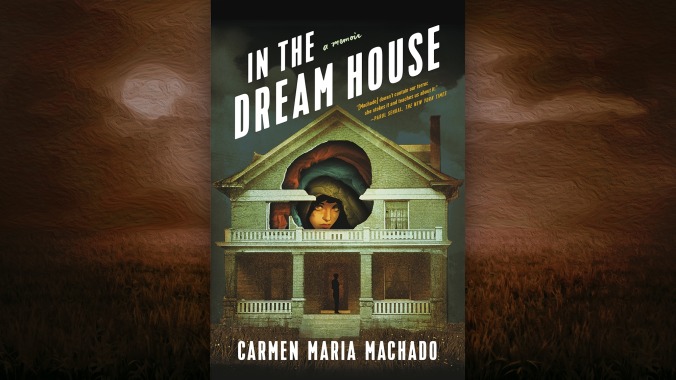
In the Dream House
31 May, 2021
“The Dream House was never just the Dream House. It was, in turn, a convent of promise (herb garden, wine, writing across the table from each other), a den of debauchery (fucking with the windows open, waking up with mouth on mouth, the low, insistent murmur of fantasy), a haunted house (none of this can really be happening), a prison (need to get out need to get out), and, finally, a dungeon of memory. In dreams it sits behind a green door, for reasons you have never understood. The door was not green.” — In the Dream House, Carmen Maria Machado
In May 2021, I read Carmen Maria Machado’s experimental memoir, In the Dream House. Published in 2019, it’s a cathartic, candid and powerful account of of psychological abuse experienced by the author during a past relationship. But it’s also about memory: its slipperiness and unreliability, and how complex, unsettling and surreal it can be to reckon with the legacy of those memories.
Using the ‘dream house’ Machado and her first girlfriend shared as its central motif, the memoir kaleidoscopes between time genre, and style, its lushly lyrical non-linear fragments describing the relationship’s early joys and pleasure alongside the darkness and pain they transitioned into using tropes from lesbian pulp fiction, psychological thrillers and even a choose-your-own-adventure.
As inventive and meticulous as her 2017 short fiction collection Her Body and Other Parties, In the Dream House is playful, thoughtful and imaginative, and uses all those attributes to distort and subvert the reader’s expectations, make unexpected connections and create such a hypnotic, entrancing atmosphere that I found myself reading it compulsively, completely sucked in. There’s a dawning horror to it as the memoir goes on, one that mirrors the subject matter so perfectly I’ve had to force myself to put it down and take breaks in-between reading.

Going back through the book, I found the passages I’d underlined:
In the pit of it, you fantasize about dying. Tripping on a sidewalk and stumbling into the path of an oncoming car. A gas leak silently offing you in your sleep. A machete-wielding madman on public transit. Falling down the stairs, but drunk, so you flop limb over limb like a marionette and feel no pain. Anything to make it stop. You have forgotten that leaving is an option.
This, I remember. I remember digging through the chaos of a kitchen drawer in that high-rise Miles Platting flat, counting the number of paracetamol in the handful of half-used silver-foil blisterpacks. How many would be too many? Or did I even have enough? No internet in the flat, no smartphones, no easy way to check the numbers. I couldn’t make myself take the risk, but the panic of realising being stretchered out by paramedics felt more possible than leaving is the sensation that stays with me still.
A reminder to remember: just because the sharpness of the sadness has faded does not mean that it was not, once, terrible. It means only that time and space, creatures of infinite girth and tenderness, have stepped between the two of you, and they are keeping you safe as they were once unable to.
The tenderness of time is something I am grateful for. I am no longer as afraid as I was. I will probably never forgive. But I am softer in my relationship now, a haven of compassion and trust that has taught over many years that perhaps I am safe enough now to ease the habitual near-constant hypervigilance. It was once terrible, but now it’s not. And the tenderness of time has made me softer towards who I was then: for years, I blamed her, held her responsible. Should’ve known better, should have left sooner. Infinite hypotheticals to make the past take a different track. When I think of her now, it’s with both grief and pride. She held on, and we survived.
Reading In the Dream House allowed me to see possibilities for writing about the things that hurt in ways that obfuscate, distort, invent. How something can be both brutally truthful and wildly imaginative. I habitually use fiction writing as a way of processing real-life experiences, but one of my intentions with starting my newsletter was to get braver about writing more honestly. To build a practice of making myself and my experiences visible in a different way. But there are certain topics I’m still afraid to write about, even for myself.
Reading In the Dream House helped me make an attempt at writing about my own experience of being in abusive relationship. I went through my old diaries and brain-dumped pages and pages describing my most vivid, hard memories from that time. Then I had nightmares for three nights straight and didn’t go near that Word doc again. So I’m still figuring out what level of candour and real-life blood and guts is right for my writing. I have conflicted emotions about the level of performative bloodletting and potential retraumatising we sometimes expect from ourselves and each other when we write material about our lived experience, which was strangely affirmed when I read an interview with Carmen Maria Machado in which she described the process of writing In the Dream House:
“It was horrible,” she said. “It made me more depressed and kind of killed a little part of me. I was sitting alone in a little cabin in New Mexico trying to write about the worst thing that ever happened to me. I thought I was ready to write the book, and I don’t know if I was but I did it. If I said it was a good experience, I’d be lying. It was not a good experience at all.”
Not long after reading, I listened to this interview between Carmen Maria Machado and Connor Habib, whose brilliant essay If you ever did write anything about me, I’d want it to be about love was one of Carmen’s inspirations while writing her book. They have a beautifully in-depth conversation about body horror, desire, spirituality, queerness, abuse, resilience, all the intersections between them and so much more.
Returning to my notes from reading In the Dream House, I found this quote on a nearby page:
Collective trauma is unending. There is no respite from it. And for marginalised groups, there is the vulnerability of compounded collective traumas. It is that reality that shapes how I think and how I write. So many of us are shaped by collective trauma and our personal traumas. And some of try to share our stories. We try to find the right words. We try to be truthful and fair to ourselves, to others. We try to be free. There is no pleasure to be had in writing a trauma. It requires opening a wound, looking into the bloody gape of it, and cleaning it out, one word at a time. Only then might it be possible for that wound to heal — Roxane Gay, Writing into the Wound: Understanding trauma, truth, and language
In writing about trauma, the line between hurting and healing can be hard to recognise: its location shifts, or it’s invisible, or it’s maybe not even there at all. And so how to do it with gentleness and courage and defiance and acceptance is for me an ongoing practice and experiment. But there’s something about this final quote I’ll share from In The Dream House that leaves me hopeful about what could be harnessed in the process:
Our bodies are ecosystems, and they shed and replace and repair until we die. And when we die, our bodies feed the hungry earth, our cells becoming part of other cells, and in the world of the living, where we used to be, people kiss and hold hands and fall in love and fuck and laugh and cry and hurt others and nurse broken hearts and start wars and pull sleeping children out of car seats and shout at each other. If you could harness that energy — that constant, roving hunger — you could do wonders with it. You could push the earth inch by inch through the cosmos until it collided heart-first with the sun.
Find out more
Read an extract from In The Dream House (The Cut)Read a review of In the Dream House (AV Club)Tags: trauma, Roxane Gay, Connor Habib, survivorship, abuse, Carmen Maria Machado, In the Dream House, reading notes, queerness